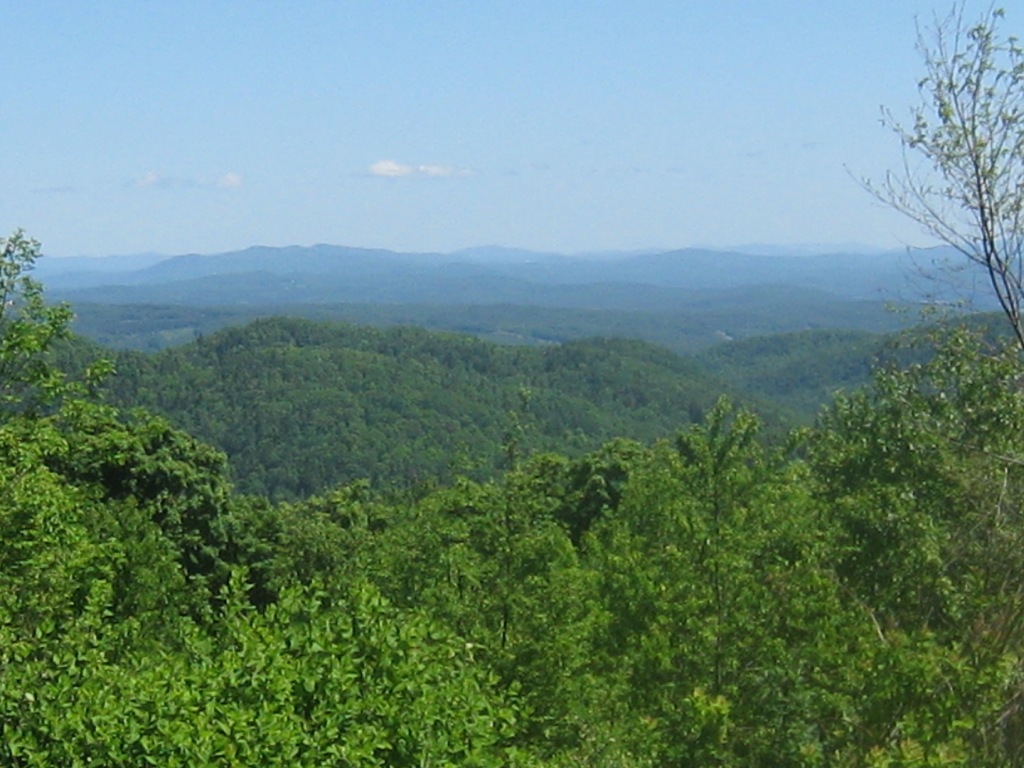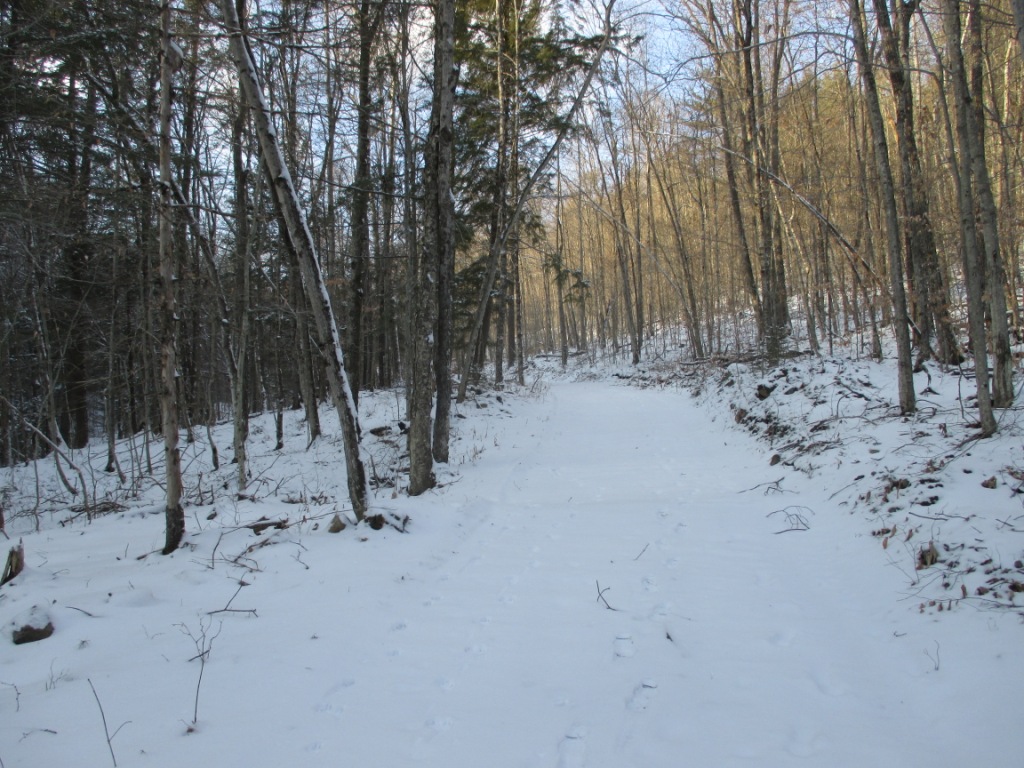Contents:
Pedestrian Recreation
Vehicular Recreation
HuntingPedestrian Recreation
There are presently about 25 miles of hikeable forest roads and trails in Fairlee Forest (excluding older unmapped skid roads), and another 5-10 that are open to the public on private land (Palisades Trail and Sawyer Mountain Trail). Those in the Fairlee Forest connect with those in West Fairlee’s Brushwood Community Forest (BCF) and extend north to BCF’s recent addition of land formerly belonging to the town of Bradford. The 36-mile Cross Rivendell hiking trail traverses the Fairlee Forest east to west from the Appalachian Trail intersection on the summit of Mount Cube in New Hampshire to Flag Pole Hill in Vershire, Vermont.
A favorite destination within Fairlee is Bald Top Mountain, with its panoramic views of the surrounding Vermont hills and New Hampshire’s White Mountains. In 2014 the Fairlee Forest Board removed trees that had been encroaching on the view and the non-native buckthorn trees that had been replacing native shrubs on open ground. Bald Top can be reached from a number of the old forest roads, but most hikers prefer the Cross Rivendell Trail. Other nice destinations are Eagles Bluff on Echo Mountain Trail, with its view over Lake Morey; Glens Falls, reached either from the lower Cross Rivendell Trail or a path along the brook from Lake Morey Road; the downstream Connecticut River views on Palisades Trail; and big upstream Connecticut River views from Sawyer Mountain.
In winter, there is no limit to possibilities for snowshoeing in Fairlee, including in Fairlee Forest, and, although the steep terrain is extremely challenging on skis, adrenalin junkies with expert skills and the right equipment have been known to venture on the VAST trails when snowmobile traffic (never heavy) is particularly light midweek. For maps and more detailed trail descriptions please see the Maps & Trails page
Vehicular Recreation
Fairlee Forest’s groomed snowmobile trails are part of a truly “VAST” (Vermont Association of Snow Travelers) network extending across the Northeast and into Canada. Fairlee members of VAST keep its section of trail so well-groomed and compacted that, in a good winter, they make for excellent hiking tracks with none of the ruts and boulders evident in summer and no need for snowshoes. People have even been known to sled and ski on them, though this is obviously risky. In the early days when snowmobiles were noisy and polluting, and some drivers were disrespectful of private property, increasing restrictions were being proposed to limit snowmobile use. Since then, VAST has worked hard to make good citizens and neighbors of its members. The machines themselves are much quieter and cleaner now, and the operators in Fairlee Forest set a good example of what courteous, responsible vehicular recreation should be.
The Vermont All-Terrain-Vehicle Sportsman’s Association (VASA) has the same goals as VAST but a more difficult job. Vehicles operating on dirt trails invariably cause wear and tear, but especially so where trails are wet or muddy. While most drivers in Fairlee Forest are responsible, it only takes one vehicle during mud season, or one hot-rodder in any season, to undermine a trail people have been working to repair. The same is true of trucks, which according to one knowledgeable source, are the main cause of damage to forest roads.
ATVs are only permitted (per the Town Ordinance) on forest roads or trails that have a sign stating that ATVs are allowed, and at the present time, there are none.
Hunting
As long as people have lived in this area, they have hunted game in what is now Fairlee Forest. Except for the century and a half when we denuded the hills with unfettered logging and sheep grazing, wildlife abounded. As forests grew back and wildlife was able to return, we ‘predatory’ humans kept competing predator species like wolves and mountain lions out, or had exterminated them so successfully that they could not recover. As a result, humans unwittingly assumed the responsibility for keeping nature in balance — for killing only enough deer and other game for food or sport to keep those populations from overwhelming their food sources, succumbing to diseases, or changing the forest ecosystem in ways that could impact other plant and animal communities. Until recently, this has worked quite well. Agencies like Vermont Fish and Wildlife Department and organizations like the Vermont Natural Resources Council, as well as a number of hunting organizations, provide research services, guidelines, and regulations that help responsible hunters manage game sustainably both for the game and the ecosystem. Several Vermont organizations, like the Quality Deer Management Association actively work to recruit and train new and younger hunters in order to keep the ratio of predator to prey in balance.
As the hunting community ages or has less time to spend in the woods, some sportspersons and environmentalists are concerned that the population of white-tailed deer in parts of the state — Fairlee among them — is becoming too large and are pressing for changes in quotas. For example, in spite of the number of both local and outside hunters who flock to Fairlee Forest in the fall, our herds may already be causing declines in desirable native plants like trillium and pink lady slipper, but also in potentially valuable oak and sugar maple saplings. Except in northern and western parts of the forest, it is difficult even to find trilliums, which are normally active colonizers. This may be a result of soil conditions rather than predation, but it would be worth studying the prevalence of these plants in Fairlee Forest, and if they appear to be declining, take steps to protect remnant specimens from browsing deer.
Non-hunting forest visitors should be aware not only of the various hunting season dates but the fact that hunting for non-restricted species may occur year-round in Fairlee Forest, as does target practice. While most hunters are well-trained and responsible, and there has apparently never been a mishap here, visitors should always take precautions while in the woods by wearing bright colors and avoiding areas where guns are being fired. For their safety, dogs should sport a bright bandana or vest and be kept on leash or under voice command.
Trapping is also legal in Fairlee Forest and in several local Wildlife Management Areas. Vermont Trappers organization has a branch in West Fairlee.
For Vermont hunting and trapping regulations please visit www.eregulations.com/Vermont.



